The Full Circle
The centuries roll back for the occupants of the moon through a time warp of 40,000 years to the Stone Age, and meeting up with themselves as cavemen. ITC summary
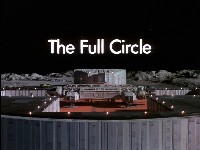
- Original script by Lasky and Silver is lost, but a SFX shot list was dated 25th July 1974. Landau comments on original script
- According to Bob Kellett, he rewrote most of the script. He also pushed for the crew to do an exterior location (the only prior exterior shooting was one scene in the studio car park in The Last Sunset). The location was the studio backlot (also used for Matter Of Balance and Journey To Where in Year 2). As it was autumn 1974, it was cold and wet with authentic mists.
- Shooting script 17th September 1974
- Filmed 24 September- 8 October 1974
- Insects bit Zienia Merton's legs, and to keep warm she was given brandy- which made her fairly drunk. Bob Kellett insisted the leopardskin dress she wears be an authentic skin which she had to tie on with no underwear. When slumping against the tree at the end of the chase she kept falling out of it.
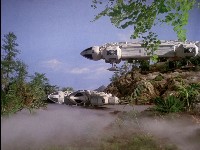
Three Eagles are seen together in two of the landing shots; one is obviously a cardboard cut-out (only two 44" Eagles existed at the time).
- Original score by Barry Gray, composed and arranged in Guernsey. Recorded at Wembley on Tuesday 3rd December 1974
- Library track from Thunderbird 6 by Barry Gray
- ITC Music Cue Sheet
As the camp awakens, Bergman is whistling Grieg's "Morning Mood" (Morgenstemning) from Peer Gynt, written in 1875. Thanks to Jordan Orlando.
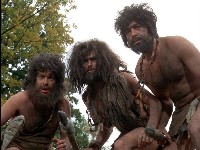
- Cro Magnon were the first modern human species in Europe, contemporaneous with and displacing the Neanderthal. The name comes from the rock shelter of Cro Magnon in the Dordogne Valley in France, in which skeletons were discovered in 1868. The first modern humans appear in Africa 200,000 years ago, and spread from Africa around the world between 120,000 and 60,000 years ago. In Europe Cro Magnon arrived about 40,000 years ago. Their culture, termed Upper Palaeolithic, included sophisticated stone, bone and horn tools, the first spears and whistles, and the first cave paintings. They were nomadic hunter gathers; caves would have been temporary homes, not permanent. In the 1970s, Cro Magnon was a term used for modern humans throughout the world, but now it refers just to the first humans in Europe. Bergman states the Cro Magnon date to 40,000 years ago, which in the 1970s would have been 5 to 10,000 years too early. More recent discoveries have pushed the dates back to make Bergman correct.
- As they were identical to modern humans, Cro Magnon could speak. From the evidence of their art and tool making, and regional trade, they must have had language. The depiction of the grunting cave dwellers in this episode thus does them a disservice. It is generally believed that some forms of spoken language begin with either Homo ergaster (1.8-1.3 million years ago) or Homo heidelbergensis (0.6-0.2 million years ago).
- The Cro Magnon were dark skinned. Lighter skin evolved much later, in the middle East and central Asia; light skinned tribes entered Europe bringing the new invention of agriculture, around 7000 years ago. These tribes largely wiped out the original Cro Magnon hunter gatherers, although a small proportion of their DNA survives, along with a little from the Neanderthal early humans that lived in Europe before the Cro Magnon.
- Other animals in the forest include creatures with long mammoth-like tusks, and the animal that made the footprint found by Koenig and Helena. It has four forward-facing long toes and a deep heel imprint, suggesting a large plantigrade bipedal animal like a therapod dinosaur or ostrich.
- The time warp also changes clothes and hair (beards suddenly appear), and instantly gives them a social structure and hunting skills (note the pit trap and mammoth tusk). Alphan uniforms disappear, but dental work remains. When they return through the mist, they are cleaned, shaven, and returned to their uniforms.
- The nights at the landing site are 2 hours long. Evidently Retha is tilted on its axis, perhaps more so than Earth. Hence during the summer, days are longer and nights are shorter. Perhaps the Alphans also landed at higher latitudes, where the effect is more pronounced (within the tropics it is always about 12 hours day, 12 hours night). On Earth, the 65th North parallel, crossing Alaska and Baffin Island, has 2 hours of night in summer.
From when the rescue mission sets out, they are in range of the planet for 3 days. When Koenig has been returned to Alpha Medical Center, there are less than 2 days left.
1 fatality, Sandos.
Alpha Technology:
Eagle 1 (Koenig); 2 (Alan); 3 (Victor); 6 (original landing party)
Retha.
Aliens:
None
Footage:
- This episode contradicts The Testament Of Arkadia where humanity was founded by colonists from Arkadia about 25,000 years ago (15,000 years after Cro Magnon society).
- For the first time, the first landing on a planet is by a team that does not include Koenig or the other main characters.
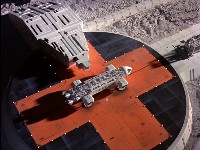
Kano and Bergman's Eagle 3 is seen first with the tube to port (this shot). It launches with the tube to starboard.

The wooden edge of the false ceiling is visible top right.

The Eagle on the left is a 2-dimensional cut-out.
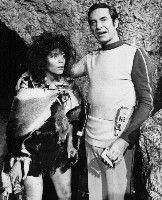
- Unusually, the title cards (episode title and credits) do not immediately follow the series titles; instead Koenig briefs the others, and the captions only appear when the Eagles leave.
- We see a shaking tree and a large footprint and hear animal cries, but the dinosaurs are never seen. The cave people have a large mammoth tusk, paint bison and have built pit traps, so they have evidently encountered the wildlife.
- Barbara Bain's daughter Julie brought home her first boyfriend during the filming of this episode. Unfortunately her mother was still in cave woman make-up, practising her blood curdling screams.
- Although Sandra sleeps in the Eagle she gets kidnapped. Is it wise that Bergman, Kano and Alan camp outside the next night?
- A focus on characters and humour ("Give my love to Sandra" "Not if I can help it" "I hate backseat drivers")
- The core idea of the episode is good ("I'd really like to know how much we've changed over all that time"; communication) but the grunting cavemen are difficult to take seriously.
- "A good basic story idea that was spread much too thinly" 3/5 Critical Commentary by Johnny Byrne (1975)

External Links
![]() Year 1 - Episode 15
Year 1 - Episode 15 ![]()


